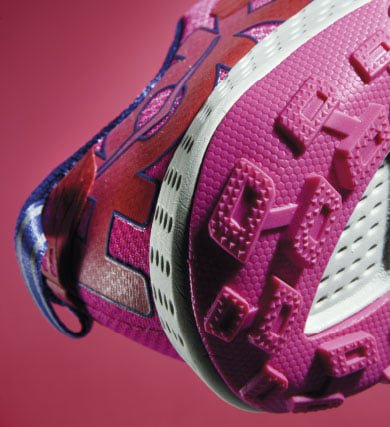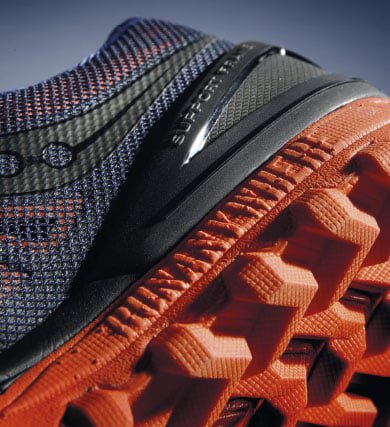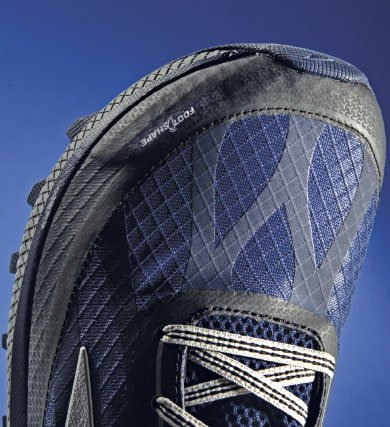15 Awesome Treads For The Trail
When it comes to trail running, maximal cushioning is still king; but there are those who prefer less shoe and more feel for the trail. RW Gear Editor Ryan Scott reviews the best of both worlds.
When it comes to trail running, maximal cushioning is still king; but there are those who prefer less shoe and more feel for the trail. RW Gear Editor Ryan Scott reviews the best of both worlds.
01/ Saucony Peregrine 7: R2 350
The Peregrine 7 is versatile. Saucony removed a block of bouncy foam from the heel, and gave the shoe a thin, full-length layer of the same material, directly below the sockliner. The upper has a durable thermoplastic polyurethane (TPU) wrap over the mesh. A nylon-fibre rock plate continues to provide excellent push-through protection, without hindering flexibility too much. 276g
02/ Hoka One One Speed Instinct: R1 995
The brand has a huge market share in the USA and Europe, and now it’s available in South Africa, everyone’s talking about it here too. A sleek- and slim-looking shoe, the Speed Instinct features a lower-to-the-ground midsole (compared to other Hokas), and a firmer forefoot that allows for quick push-offs. It’s similar to Hoka’s new road shoe, the Tracer. Plus, it offers a trail-gripping sole, and a more protective upper. Testers were happily surprised by how light the shoe felt, from the moment they put it on. 255g
03/ adidas Terrex Agravic Boost: R2 000
For stability, the Agravic uses a firm EVA cradle, which rests on top of a bouncy, cushioned midsole made of Boost foam. The outsole lugs are 4.5mm deep, which means the Agravic has greater traction than most of the shoes in this review, and the larger spaces created by the lugs drop mud more easily. Testers commented that the lacing system (which now has fewer eyelets), a lightweight EVA tongue, and a great design all help lock the foot down with minimal fuss. 314g
04/ Skechers GO Trail: R1 530
The max-cushioned GO Trail Ultra is now in its third generation. The latest version has the same roomy fit and smooth ride, but the brand has shaved about 8mm off the midsole height and 42 grams off the overall weight. Because your foot will now be closer to the ground, Skechers have added a rock plate for extra protection and stability. 204g
05/ Saucony Xodus ISO 2: R2 650
The Xodus conquers rocky, root-filled trails like a tank. In this update, Saucony have included a proprietary outsole, which our wear-testers found gripped everything they threw at it – both wet and dry – and showed little sign of wear, even after 100-plus kilometres. Chevron-shaped lugs run from edge to edge and are flattened on the bottom, for a smooth ride on stretches of road. There is plenty of toe room. Cushioning and spring protect the foot from rocky terrain. 303g
06/ adidas Terrex Agravic Speed: R1 800
A lighter version of the Agravic Boost, which draws its inspiration from the technology used to build paragliders’ chutes. The fabric is super-light, strong and supportive, especially at the heel. Not only is the stack height lower in the Speed; the heel width and footprint match the shape of the foot more closely than any other trail shoe we’ve seen. The snug fit will suit some runners, but for others it might feel a bit close. The Speed doesn’t have Boost foam, so it’s best suited to those who are more concerned with their own running form than energy return. 249g
07/ Asics Gel Fuji Trabuco 5: R1 900
The Trabuco 5 Neutral has everything you’d want from a trail shoe: a durable, deep outsole tread; strong cushioning; a wide, stable platform; a rock protection plate in the front toe area; and protective overlays on the upper. It has everything but nimbleness – some testers were a little meh about the shoe, while others welcomed the support and comfort. Those who like the ride of traditional Asics road shoes should appreciate this off-road model. 334g
08/ Mizuno Hayate: R2 200
Though it feels like a substantial trail shoe, the Hayate 3 is light, low, and flexible. The three-layer upper has been engineered to lock down the midfoot, and a mesh covering allows the toe to breathe and flex. It has a padded, protective upper and a firm, stable ride. Several testers who had expected a more nimble feel found the shoe a bit bulky, but all appreciated its ruggedness on gnarly trails. “What a lifesaver it was when I needed more traction and durability on the wet trails of Newlands, which are lined with rocks and hidden tree roots,” commented Sharon Becker of Constantia. 255g
09/ Salomon Sense Marin:R2 699
The S-Lab shoes may be lightweight and fast, but they aren’t as durable as the Sense range. The Sense Marin withstands long distances, and pretty much any terrain. It has a contragrip outsole for wet terrain, and lugs in a variety of places that protect feet from rocks. Testers praised the 6mm heel-to-toe offset, because they enjoyed feeling closer to the ground. 272g
10/ Altra Superior 3.0: R2 200
The zero-drop profile, flexible Superior 3.0 moulds to your foot above and below like a moccasin, letting you glide lightly over the trail. Extra-soft EVA foam in the midsole provides excellent cushioning, which protects your feet from feeling beaten up. A rubber flare on the outsole aids stability. Additionally, Altra has made the outer fabric more robust and durable. 260g
11/ Salomon S-Lab Sense Ultra: R3 499
So far, the S-Lab line has only been worn by the elite few. But thanks to Francois D’haene – a larger runner who works for Salomon – the brand has released a version more relevant to the masses. “Expect the best performance features of the S-Lab Sense 5 Ultra, coupled with added cushioning and protection for technical terrain,” says Pat Heine, a 160km racer. 274g

12/ Brooks Pure Grit 6: R2 400
Besides the Altra, the Pure Grit has the lowest profile of all those we have tested – just 4mm. The low stack height, which brings the foot closer to the ground, will suit trail runners who prefer to feel close to the dirt under their feet. A shield plate protects against intrusive rocks. The upper displays the only change from the previous Grit 5, which was a favourite of our testers. It’s more durable and stretchy – that’s good news for those running on tough South African terrain, which tends to rip up shoe outers before the cushioning even has a chance to bottom out. 273g
13/ Asics Gel FujiAttack 5: R1 800
The FujiAttack 5 is a rugged crossover shoe that can handle any terrain, be it road, gravel or technical singletrack. A new upper, incorporating Discrete Eyestay Lacing technology, is designed to adapt to foot movement. The entire outsole is made of Asics’ durable, high-abrasion rubber, and features a variety of lugs for traction on any surface. The shoe runs like a traditional lightweight trainer, with a 10-millimetre drop, a rigid mid-foot bridge, and a firm, responsive forefoot. Good value. 329g
14/ NB Fresh Foam Hierro V2: R2 400
Another ultra-distance option from New Balance, the Hierro has a soft, fairly flexible sole, for protection during long efforts on rugged singletrack. The forefoot lugs are angled to pull you forward, and the heel lugs bite solidly on descents. A beefed-up toe cap shields your feet from rocks. 297g
15/ Puma 300 TR V3 Ignite: R2 200
Puma have added a midsole section of Ignite foam, but this is still a good option for runners who have narrow feet. The upper is simple and lightweight, and the Everfit lacing system has extra-stength loops at the top end, all of which lock the foot down firmly. It feels tactile and close to the foot, which is ideal for running on uneven surfaces. Grippy, multi-directional lugs are great for speedwork and running at night. Testers praised the shoe’s responsiveness, flexibility, protection, light weight and breathability. 288g
READ MORE ON: gear trail trail-shoes








